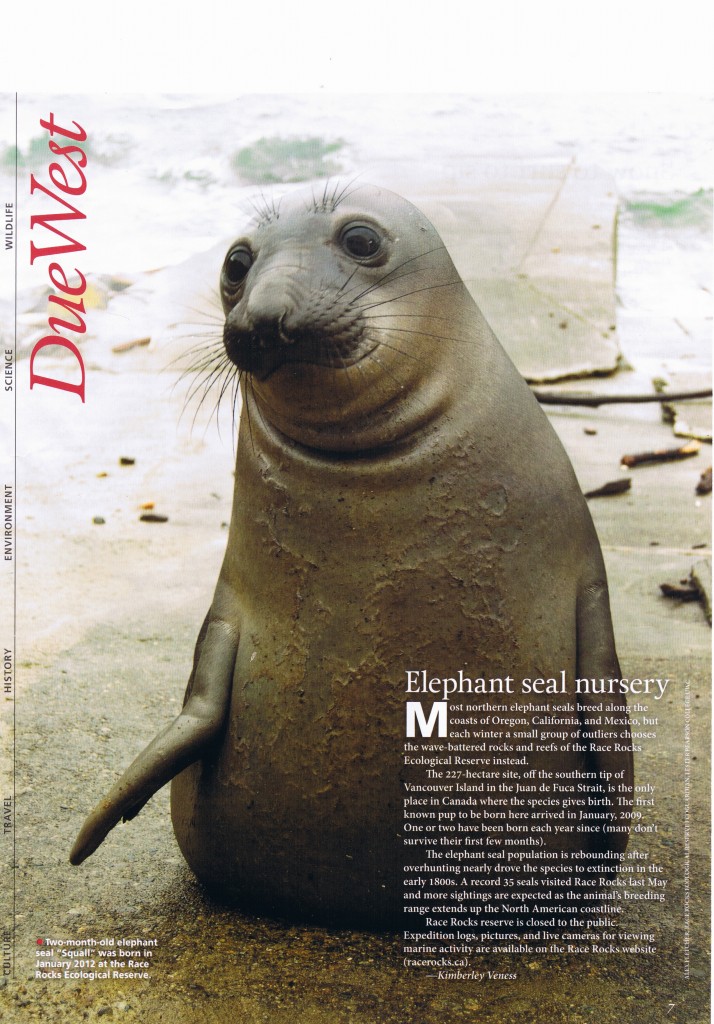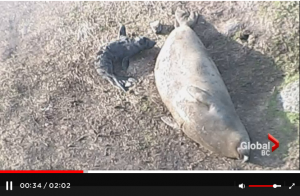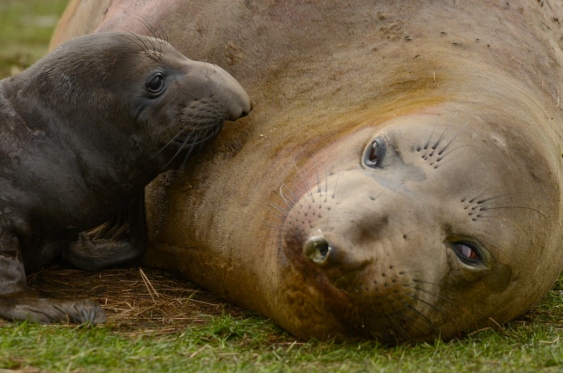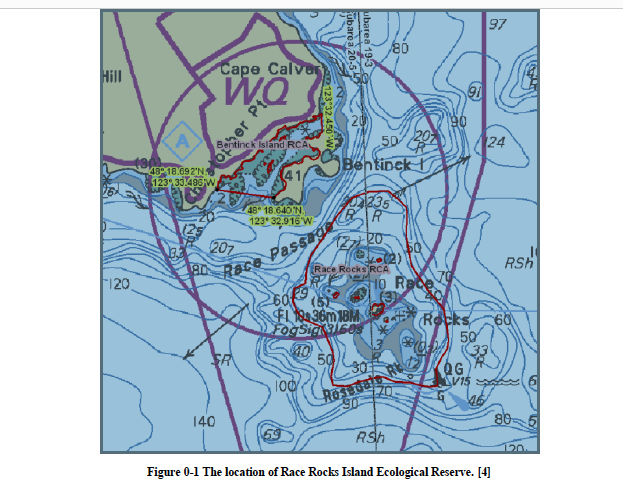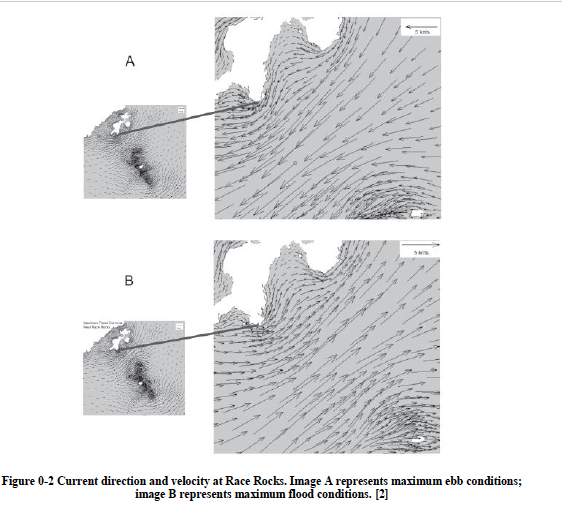The following article from the Victoria Times Colonist with a video of an interview with Dr. Martin Haulena of the Vancouver Aquarium appeared in the Times Colonist on October 29 2024 concerning the rescue of an entangled sea lion at Race Rocks Ecological Reserve:
Category Archives: Media
Index of Articles Published on Race Rocks ER in the Friends of Ecological Reserves Log-1988-2023
ECOLOGICAL RESERVES — NEWS/ARTICLES:
#97 Race Rocks: threatened loss of keeper — Fall 1996
#97 Race Rocks: marine protected area — Autumn 1998
#97 Race Rocks Marine Protected Area — Winter 2000
#97 Race Rocks news update — Winter 2001
#97 Race Rocks: ER to Marine Protected Area — Spring 2003
#97 Race Rocks: An Unusual Model — Winter 2004
===========================================
VISITS and REPORTS:
#97 Race Rocks — Spring 1988
#97 Race Rocks — October 1989
#97 Race Rocks — Spring 1997
#97 Race Rocks — Fall 1997
#97 Race Rocks field trip — Winter 2005
#97 Race Rocks field trip — Winter 2006
#97 Race Rocks field trip — Spring/Summer 2013
#97 Race Rocks: Pungent to Educational — Winter 2007
#97 Race Rocks Visited — Autumn 2008
#97 Race Rocks Re-Visited — Spring/Summer 2010
#97 Race Rocks Trip — Spring/Summer 2014
===============================================
ARTICLES:
Race Rocks ER: Marine Protected Area — Aut./Win. 2009
Elephant Seal Born at Race Rocks — Winter 2008
Race Rocks: Elephant Seals Born — Spring/Summer 2018
===============================
PROFILES:
Trev Anderson — Autumn-Winter 2020
Pam Birley — Autumn/Winter 2010
=====================================
Link to the Index of publications on British Columbias other Ecological reserves
Archives of Victoria Newspaper Articles on Race Rocks
The British Colonist Newspaper Archives 1859-1906
https://racerocks.ca/newspaper-archives-1859-1906/
Since the last time I looked at the digitized versions of the early newspaper of Victoria, further work has been done by the University of Victoria Archives in digitizing and more of the early Victoria Newspaper references to Race Rocks have been found. Here are some that I have come across to date..
1858/08/12 .. (page2 left column)Lighthouse Commissioners: HMS Plumper, Capt. Richards left Esquimalt Wednesday morning to select a site for a lighthouse on Race Rocks…
https://archive.org/details/dailycolonist18590812uvic/mode/1up
1934/12/30 Historic Race Rocks Lighthouse (recounts construction of lighthouse as well as story of Davies and tragedy)
https://archive.org/details/dailycolonist19341230/page/n26/mode/1up?view=theater&q=race+rocks
1970/04/26 Californians Come for Good Life. (California Sea Lions)
https://archive.org/details/dailycolonist19700426/page/n70/mode/1up?view=theater&q=race+rocks
1070/06/07 In Stiff Wind off Race Rocks Yacht Mishap Kills Four
https://archive.org/details/dailycolonist19700607/mode/1up?view=theater&q=race+rocks+rock
1970/08/09 Unusual Homecoming .. ( Race Rocks Construction, light-keeper George Davies )
https://archive.org/details/dailycolonist19700809/page/n57/mode/1up?view=theater&q=race+rocks
1971/09/26 Dreaded Race Rocks : https://archive.org/details/dailycolonist19710926/page/n75/mode/1up?view=theater&q=race+rocks+rock+race%E2%80%99s
1977/02/20 Race Rocks Treasure. ( Thomas Argyle)
https://archive.org/details/dailycolonist19770220/page/n71/mode/1up?view=theater&q=race+rocks
1977/10/02 Zone of Silence
https://archive.org/details/dailycolonist19771002/page/n80/mode/1up?view=theater&q=race+rocks
178/04/23 Sea Lions Transients of the Coast. ( Stellers sea lions)
https://archive.org/details/dailycolonist19780423/page/n82/mode/1up?view=theater&q=race+rocks
Elephant Seal Pup Growth – Day by day
The first Elephant Seal pup of the 2021 birthing season came on December 22 2020, and began it’s 23 days of nursing the day after (it took him awhile to figure out how to nurse). Elephant seal pups only have a couple of weeks to get big enough and healthy enough to survive alone after their moms wean them and abandon them on Race Rocks; which means their life is essentially just to feed, nap, and snuggle with their moms. It’s hard to show how impressive it is to see how fast they put on weight, with the pup doubling in size over the first few days. Here’s a video of the growth of ‘Cheermeister’ over his first 12 days of life.
https://youtu.be/ltMsnNRYTmU
Also see other posts on elephant seal pups born at Race Rocks, the most northerly pupping colony for e-seals on the Pacific coast: https://www.racerocks.ca/tag/pup/
Squall featured in BC Magazine, Winter 2014
This photograph taken at Race Rocks by Alex Fletcher in January 2012 was featured in the British Columbia Magazine Winter 2014. This female elephant seal (Squall) was born at Race Rocks and was successful in leaving theisland without injury.
B.C. coast, St. Lawrence estuary most at risk for major marine oil spill: report
The Canadian Press January 29, 2014 01:24 PM OTTAWA — A government-commissioned risk analysis says the coast of southern British Columbia and the Gulf of St. Lawrence are the Canadian areas most vulnerable marine oil spills and among the most likely for a major spill to occur. The findings will add to the debate over several pipeline proposals — including two in B.C. that the report says will substantially increase marine risks. The 256-page study, delivered this month to Transport Canada, looks at the risks associated with marine oil spills south of the 60th parallel under current shipping volumes.

The southern tip of Vancouver Island — including Race Rocks — is among sites considered vulnerable to oil spills. Photograph by: Dan Kukat
It identifies the southern tip of Vancouver Island, the Cabot Strait off Newfoundland, the eastern coast of Cape Breton Island and the Gulf of St. Lawrence as the most probable areas for a major oil spill. But the study also assesses the potential impact of four proposed pipeline projects, including the Northern Gateway Pipeline to Kitimat and Kinder Morgan’s plan to almost triple its Trans Mountain line into Vancouver. The report says the Kinder Morgan proposal would essentially double oil traffic in an already vulnerable marine environment — with a corresponding increase in spill frequency — while the Northern Gateway marine route would turn what are currently very low, near-shore risks into very high risks. The study found that reversing Enbridge’s Line 9 to carry Western Canadian crude to refineries in Montreal and Quebec City would actually lower marine spill risks, as it would reduce oil imports through the sensitive Gulf of St. Lawrence. And the study found that the proposed Energy East Pipeline to St. John, N.B., would likely be a wash, reducing shipping imports but increasing oil exports to leave the overall marine risk about where it is now. © Copyright Times Colonist
- Other posts on this website about the risk of oil spills in the Strait of Juan de Fuca from increased Oil tanker Traffic.
- Posts on the Ecological Reserves website about the risk of Oil Spills
- Posts on the Ecological Reserves website about the Marine Reserves of BC
Also see:
B.C. coast, St. Lawrence Estuary most at Risk for Major Marine Oil Spill: Report
Video: Elephant seal pup born on Vancouver island is an online star : Global TV
(Global TV toured the waters of Race Rocks and did an Interview with the Ecological Reserve Warden Garry Fletcher on January15: Click on the image to see the article .
An elephant seal pup is getting used to the watchful eye of the Internet.
Its every move is being broadcast by a webcam to people watching around the world.
It was born in the early morning hours of January 14 at Race Rocks Ecological Reserve in the Strait of Juan de Fuca just off the southern tip of Vancouver island.
The reserve says this is the fifth pup born to a female called Bertha since January 2009.
Race Rocks is the only place in Canada where elephant seals breed and while other baby seals have been born on the reserve’s other islands, they’ve been washed out to sea by the waves.
Elephant seals were hunted to near-extinction in the 19th century, but are now protected under the Fisheries Act.
Arrival of elephant seal pup watched around the world: Times Colonist
Arrival of elephant seal pup watched around the world
Sandra McCulloch / Times Colonist
January 14, 2014 09:15 P
An elephant seal pup is nursing at its mother’s side at Race Rocks Ecological Reserve, oblivious to the fact a camera is sending its image around the world.
The pup was born Monday evening — the first birth of an elephant seal this year on the main island, said Garry Fletcher, educational director for the reserve’s website.
Another elephant seal was born last week on one of the smaller islands but rough weather washed it into the sea where it perished.
“All the ones that are born on the outer islands get washed off,” Fletcher said Tuesday. “This one is from a mother that’s had young ones there four or five times before.”
Race Rocks is the only spot in Canada where elephant seals breed, Fletcher said. Normally, elephant seals choose breeding colonies in Oregon or northern California.
There are usually a few elephant seals hanging out at Race Rocks throughout the year, Fletcher said. Last June, a record high of 15 elephant seals were counted on the reef.
Elephant seals are far out-numbered at Race Rocks by their cousins, California sea lions and northern sea lions. Males can grow to four metres in length and weigh 2.3 tonnes, more than a average car, and are often twice as big as male California sea lions.
Harbour seals, which are smaller and much more commonly seen along the coast, also use Race Rocks to breed.
The numbers of elephant sea lions are rebounding after being hunted to near extinction by the end of the 19th century. Elephant seals are now protected under the Fisheries Act.
To see live images of the baby elephant seal, go to the Race Rocks website.
© Copyright Times Colonist
Other Media in which the story is covered:
- Metro news: Jan 15/2014 Photos: Elephant seal pup born off Vancouver Island,
- The Vancouver Sun: Jan15/2014 Arrival of elephant seal pup on Vancouver Island watched around the world.
- Global BC: PHOTO GALLERY: Elephant seal pup born on Vancouver island is an online star
- The Province: Sun Jan 15 2014, Cameras let world watch adorable elephant seal pup on B.C. island
- The Huffington Post B.C. | Posted: 01/16/2014 5:41 pm EST | Updated: 01/16/2014 5:41 pm EST Elephant Seal Pup Born In Victoria Is An Internet Star (PHOTOS)
- The Star Phoenix ,January 17, 2014
Elephant seal pup born at B.C. ecological reserve
-
CBCQuirks: Arrival of elephant seal pup .
-
The Leader Post (Regina) Elephant seal born at Island reserve
The Tidal Current Turbine Energy Project in the Race Rocks Ecological Reserve
PT-13: Coastal and Ocean Engineering ENGI.8751 Undergraduate Student Forum Faculty of Engineering and Applied Science, Memorial University, St. John’s, NL, Canada MARCH, 2013 Paper Code. (PT-13 – Brown)
PT-13 Brown P.1
The Tidal Current Turbine Energy Project in the Race Rocks Ecological Reserve
Erika Lee Brown
Memorial University of Newfoundland
St. John’s, Newfoundland, Canada
ELBrown@mun.ca
ABSTRACT
There is a predicted potential of 42 000MW stored in tidal energy off the coast of Canada which remains widely untapped by the energy industries.[1] Although there has been significant research and development done in the tidal energy sector, it has been a challenge to develop a cost efficient system which has a minimal environmental impact.
In 2006, the first tidal current generator to be built and installed in Canada was deployed north of the Middle Islands in the center of the Race Rocks Ecological Reserve off the coast of British Columbia. The current generator prototype was part of a six year joint research venture between Clean Current and the Race Rock project. The project aided to power Race Rocks using a combination of alternative energy technology to minimize the environmental impact of the facilities in the reserve while providing bases for testing of structural materials of the generator.
After numerous interruptions in power supply were experienced due to mechanical and electrical problems, the final phase of the project was completed in September 2011. The generator was retrieved from the seabed and transported to Vancouver for structural analysis.
The following paper will discuss the parameters of the study, as well as the challenges and problems encountered with the deployment, maintenance and retrieval of the tidal current system. A brief investigation of the outlook of tidal current generator systems as a means of power generation within Canada will also be completed.
1 INTRODUCTION
The Race Rocks located at 123° 31’ 85W latitude and 48° 17’ 95N longitude in the Juan de Fuca Strait off the coast of Vancouver Island, British Columbia is an ecologically diverse marine area. In 2001, Race Rocks was granted Ecological Reserve Status in British Columbia, Canada as Race Rocks Ecological Reserve. The reserve encompasses the main island of Great Race, as well as eight smaller islands, the water column and the seabed out to a depth of 36.6 m. [2] The designation of reserve status was created in the mid 1970s in the province in order to preserve a unique or representative ecosystem so that they may serve for research, education and a baseline for monitoring ecological change due to human encroachment. [3]
The islands within the Race Rocks Reserve do not have any permanent resides, however there are research and accommodation facilities present as the area is frequently inhabited on a temporary bases by various researchers and professors and students from Lester B. Pearson College. These facilities were electrically supplied by 15 and 25 kilowatt diesel generators.[5]
While the area is unique due to its ecological diversity, Race Rocks is also known for the 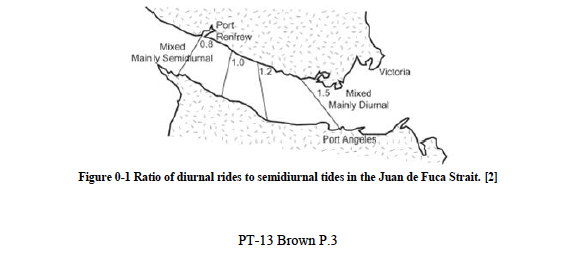 high currents present for which it was named. It is because of these high currents and the need to assist mariners with the navigation hazards that the lighthouse was establish on Great Rock in 1860. Although the lighthouse is located within the Ecological Reserve, the surrounding land is under the jurisdiction of the Canadian Coast Guard. [2] Due to maintenance costs, the Coast Guard switched powering of the lighthouse to solar energy. It was this transition to self-sufficient, low environmental impacting energy, which lead the wardens of the Race Rock Ecological Reserve to investigate similar alternative forms of energy.
high currents present for which it was named. It is because of these high currents and the need to assist mariners with the navigation hazards that the lighthouse was establish on Great Rock in 1860. Although the lighthouse is located within the Ecological Reserve, the surrounding land is under the jurisdiction of the Canadian Coast Guard. [2] Due to maintenance costs, the Coast Guard switched powering of the lighthouse to solar energy. It was this transition to self-sufficient, low environmental impacting energy, which lead the wardens of the Race Rock Ecological Reserve to investigate similar alternative forms of energy.
2 OPPORTUNITIES
Energy BC predicts that there is 42 000MW of stored tidal energy off the coasts of Canada, with approximately 7 000MW located in accessible regions along the east and west coasts which remain widely untapped. [1] The renewable energy industry is growing, with a strong research and development sector. In Canada, the majority of the research and implementation of tidal energy has been developed in barge type systems. This type of system has raised environmental concerns as they affect the natural tidal flow, as well as have notable negative impact on the marine environment.
An alternative method of extracting energy from the tides is through the use of tidal current turbines. These systems aim to utilize the natural tidal flow to turn the blades of a turbine, hence generating power. Initial research into harnessing tidal current energy revealed promising decreases in environmental impact to turbine sites and marine organisms. Prior to this case study, the design, construction, and deployment of a tidal current generator had not taken place in Canada. The strong research and tidal conditions indicative of the Race Rocks Reserve made it an ideal test site of the performance and marine impact of the new turbine design.
The bathometry and geometry of the Juan de Fuca Strait attest to the flow profile and characteristics that have been observed. The strait experiences a mixture of semi-diurnal and diurnal tides, shown in Figure 0-1, which causing upwelling of vital nutrients adding to the creation of the diverse ecosystem of the area.
As mentioned previously, Race Rocks has been historically identified as an area with high velocity tidal currents. Figure 0-2 below, from Fisheries and Oceans Canada, shows that the current can reach up to six knots through the Juan de Fuca Strait and are at their strongest at Race Rocks due to the narrowing of the channel.
As mentioned previously, Race Rocks has been historically identified as an area with high velocity tidal currents. Figure 0-2 below, from Fisheries and Oceans Canada, shows that the current can reach up to six knots through the Juan de Fuca Strait and are at their strongest at Race Rocks due to the narrowing of the channel.
Figure 0-2 Current direction and velocity at Race Rocks. Image A represents maximum ebb conditions; image B represents maximum flood conditions. [2]
3 PROJECT DESCRIPTION
The catalyst for the project was the desire of the reserve warden to have the island facilities operating in a sustainable manner using renewable energy. Prior to the commencement of the project, the island energy needs were provided by two diesel electric generators. Due to the future projected costs of the generators along with the negative effect on the marine environment as a result of the refueling and vibrations, the Integrated Energy Project was begun in Race Rocks in 1998.
1998. PT-13 Brown P.5
The desire of using sustainable energy and the unique tidal characteristics of Race Rocks made the site a very suitable location for harnessing tidal energy. Through the collaboration of Lester B. Pearson College with the Clean Current Energy Company, the Race Rocks Tidal Current Turbine Project was conceived. Pearson College benefited from the partnership by having an active educational and research opportunity and by receiving ongoing technical and monetary support from Clean Current throughout the project.
The objectives of the project partners were to:
provide sustainable energy to Race Rocks replacing the diesel generators,
contribute to the educational experience of Person College students
monitor the impact of the tidal turbine on the surrounding ecosystems,
test the seaworthiness of the turbine,
demonstrate the maintenance process for tidal current generators,
perfect the turbine structure, and
maximize turbine operation.
Clean Current Energy Company had developed a concept for the first tidal current turbine prototype to be designed and built in Canada. It was determined that the Race Rocks site would be an ideal location for testing the impact, functionality and structural integrity of the prototype.
3.1 Prototype
The tidal current turbine installed was a 1:5 scale prototype of the Clean Current Energy Company concept design. Due to the change in tidal current, the system was built to function bi-directionally. The turbine had a projected capacity of 65kW and a 3.5m blade diameter. [6]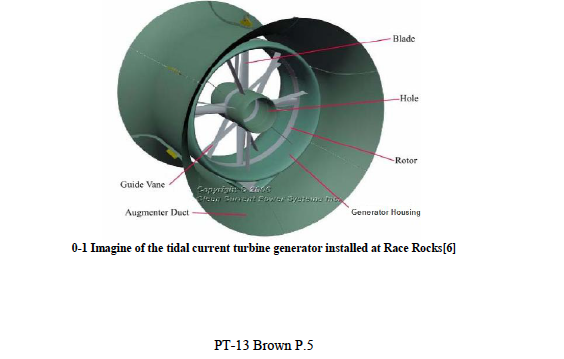
3.2 Project Timeline
Throughout the first half of 2006, the site was prepared for the tidal current energy system on Race Rocks. The boathouse on Great Race was converted into an energy storage facility with the installation of batteries and various types of electronic equipment. After a turbine site had been confirmed, the site was dredged, drilled and piles were installed. Four cables to transmit the produced energy from the turbine to the batteries were laid along the seafloor from the turbine site to the boathouse. Concrete blocks were placed alongside the underwater cable to protect them from winter storm surges and a trench was dug to accommodate the cables on land. [7] On September 27, 2006, the turbine was installed in the middle islands in the center of the reserve with a 5m clearance from the water surface.
After disappointing performance results from the turbine, it was retrieved and underwent a refit. The turbine was upgraded to include stainless steel bearings, a new lubrication and electrical wire protection system, a new reinforced fiberglass augmenter duct, and reinforced struts. Along with these new additions, the turbine blade configuration was also modified.[8] Clean Current redeployed the revamped system October 17, 2008.
The portion of the trial to be performed at Race Rocks came to an end on September 17, 2011. The turbine was removed from the sea floor by Clean Current Staff and returned to Vancouver to undergo structural analyses.
4 PROJECT CHALLENGES
Throughout the life of the project, there were a number of challengers which the partners had to overcome.
Installation of the turbine proved to be a challenge due to the high current velocities in the region. It was necessary to time the installation so that it could take place during slack tide and ensure that the majority of the installation took place before the tide turned. [8]
The first operational problem encountered in the project was an unexpectedly rapid deterioration of the turbine bearings. This caused the system to be raised in April 2007 for them to be changed out.
Throughout the life of the Race Rocks tidal project, there were a number of interruptions in energy production and transmission to the island. Problems were noted with the fiber optic cable manufacturing which lead to electrical leakage. [8]
Although the estimated generator output was 65kW, the average every production was only 12.5 kW.[9] This led to the turbine being refit and redeployed in 2008.
5 FUTURE WORK
The involvement of Race Rock Ecological Reserve, and hence Lester B. Pearson College, ended when the turbine was extracted in 2011. At that point, the infrastructural and material component of the project was continued solely by Clean Current Energy Company.
The results of the structural analysis of the turbine infrastructure due to prolonged exposure to the ocean have yet to be released. Once a better understanding of the effects ocean environment can have on the materials used for the tidal current turbine is obtained, the design prototype will be adjusted to better suit the harsh environments for which tidal current extraction can be maximized.
It is the hope that the results of this project will enable other projects of its kind to be initiated along the Canadian coasts. The end goal is for the prototype to be brought to the final design phase, allowing for commercial tide current turbines to be installed and producing significant energy to the Canadian public.
6 CONCLUSION
The installation of Canada’s first tidal current turbine generator prototype designed by Clean Current Energy in the Race Rocks Ecological Reserve was a milestone in the Canadian renewable energy industry. The tidal current profile and marine ecological information within Race Rocks made it an ideal location to not only test the structural integrity of the turbine prototype but also its environmental impact on marine life.
Although the power supplied by the tidal current turbines to Great Race Island was inconsistent throughout the life of the project, it was a valuable asset to the Race Rock Ecological Reserve’s sustainable energy program. The energy provided by the generator was able to supply a base storage of electricity to the solar power batteries now in use on the island, therefore ensuring that the island be non-consumptive in its energy usage.
Not only did the program provide a foundation for the energy objectives of Race Rocks, but the data obtained from the turbine prototype will enable Clean Current to upgrade their design to better meet the industry needs. While the results of the structural analysis are still unknown, they will greatly contribute to the further research and development of the tidal energy industry.
|
REFERENCES [1] |
E. BC, “Tidal,” Tidal, 2012. [Online]. Available: http://www.energybc.ca/profiles/tidal.html. [Accessed 19 January 2013]. |
||||||||||||||
|
[2] |
C. Wright and J. Pringle, “Race Rocks Pilot Marine Protected Area: An Ecological Overview,” Fisheries and Oceans Canada, Sidney, British Columbia, 2001
|
Sealions return
Hello all, I realise that it has been a little while since I last wrote in the daily log. Things have been busy. Ocean Educations, a three week summer diving program at Pearson College just finished this week and I’ve been busy with that, as well as keeping a German film crew of four from German public TV busy -you may have noticed Tom, Christian, Florian and Michael on the Island this week). They were busy shooting two documentaries at Race Rocks. They left this morning and I’m pleased to say that they acquired some stunning footage, above and below the water, during their stay. Things have quieted down a bit now though, so I hope to be a bit more regular in my entries for these last few weeks of my stationing at Race. Many of you will be pleased to hear that camera 5 has been repaired. Apparently there was a problem in the electrical board inside. I have it on the Island and am planning on re-installing on its mount tomorrow. If all goes to plan, it should be up and running by tomorrow afternoon. Over the last week or so, the sea lions have made quite a return. I ‘d estimate that there are probably around 100 individuals in the Reserve right now, with an equal split between northern sea lions and California sea lions. Their numbers will continue to grow as the summer draws slowly to a close. Slash is still hauled up on Great Race these days, as always. I’ve not seen Misery for a while now, although it ”s possible he’s out on Middle Rock as I saw a couple of elephant seals out there a few days ago. I suspect that Misery got a bit sick of Slash and decided to seek out some peace and quiet. There was also a mature female here for a few days late last week and early this week, but she has since left. The gull chicks are now getting quite large. Many have started to fledge and are beginning to ”test their wings ”. I ‘ve not seen any in the air yet, although I ”ve seen many flapping their limbs energetically as they try to see how their wings work! This week I also found quite a large number of dead and/or injured chicks. I think they are often attacked by other adults from outside their territory. There is actually a chick right outside my basement door that has been there for four days now; my best guess is that it wandered or ran off far from the nest then couldn ‘t find its way back. On the third day -yesterday), I woke up to find it with a broken wing. It ”s quite sad to see it huddling in the damp grass with a broken wing, while a couple of metres away, a mother feeds her three healthy chicks. Quite a stark division. I expect this chick will soon die from starvation or predation. I saw the otter several times this week. I haven ”t seen as many eagles around this week as I have in previous weeks. I ”ll keep you updated to this poor little gull over the next few days. That ”s all for now. Adam’, ’21:20:54 ,
